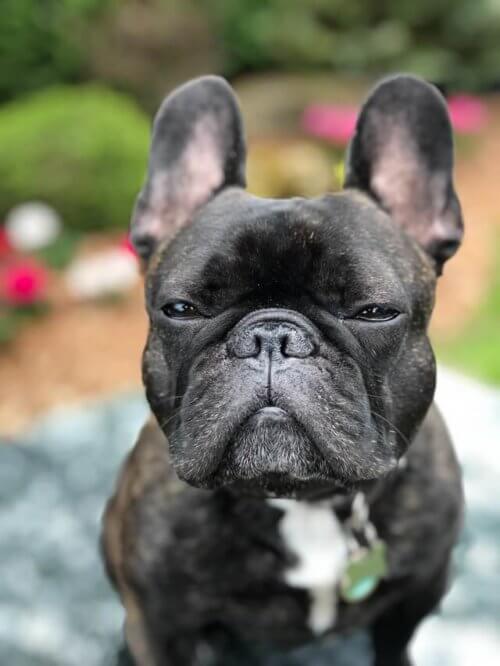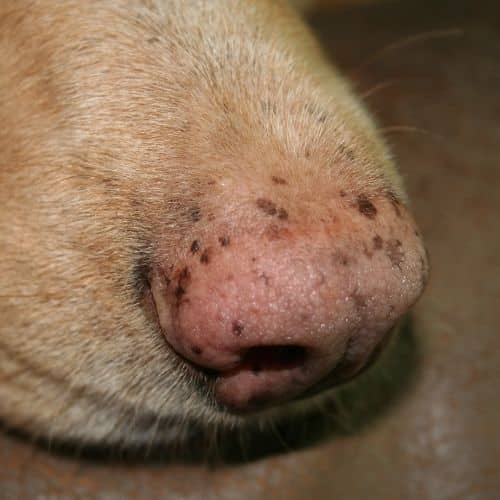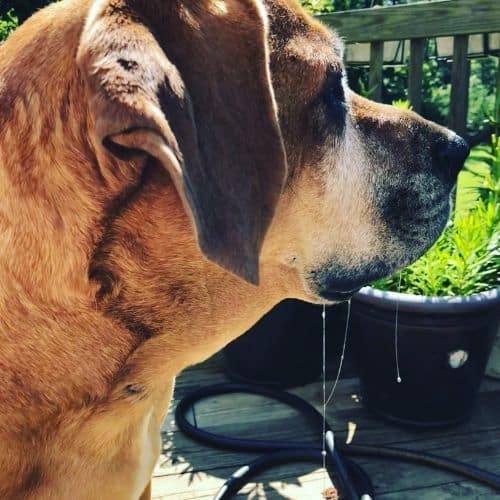If your dog was born with a white sport on its nose, it might not signify anything wrong with its health when growing up. But if you suddenly notice a white spot on dogs nose, it could be an indication of a medical condition. In some instances, it happens to be a minor cosmetic issue that disappears after a short medical input.
Whoever the reason, you need to understand the course behind your dog’s white spot on the nose to take the proper action. This article will discuss the various reasons your dog may develop a white spot on its nose and the corrective measures needed.
Which dog breeds have a white spot on their noses?

Some dog breeds might present dogs with spots on their noses. You will certainly not get worried if you notice a sport on dogs’ noses from the following breeds.
- The Golden Retriever. This British breed of the retriever dog often has hereditary Vitiligo condition. Vitiligo, a skin condition that leads to loss of skin pigmentation, affects both humans and animals. [1] Dogs don’t get spared in this health menace. However, the Golden Retriever gets affected more in the dog family, with the condition being hereditary. So, if you notice a white spot on your Retriever’s nose, you may need to head to the veterinary doctor’s office for a comprehensive diagnosis.
- German shepherd. This iconic medium to large-sized working dog originated from Germany. This breed came into existence in the late 19th century and has proven to be a brilliant protection dog. This breed, however, may be known to get affected by Vitiligo too, and the condition tends to be hereditary in these canine friends.
These two breeds get more cases of Vitiligo compared to the other dog breeds. Even though the Vitiligo skin condition may also affect other dogs’ breeds, you should take your dog to the veterinary doctor once you notice white spotting on your dog’s nose or any other part of the body.
What might be the cause for a white spot on a French bulldog’s nose?

Like other breeds of dogs, the French bulldog may experience these white spots, especially on their noses. This spot could indicate various causes and knowing them puts you in the limelight on what could be happening to your four-legged friend.
So, what could be some of the reasons for a dog’s nose changing color?
Whiteheads/pimples
As we have mentioned, the white spot you see could not be a severe health issue. Just like we get pimples and whiteheads, dogs also do. When their hair follicles clog, they experience whiteheads too. You will notice these pimples on the nose, stomach, and genital area.
The following tips will help keep your dog pimple-free
- Develop a regular grooming routine to help you wash dirt, debris, and sweat away. By washing these foreign components, the skin will remain clean, and the pores will not clog to result in pimple development. While grooming, ensure to wash the dog’s stomach, genitals, nose, and fur perfectly. If your dog gets prone to pimples, it may have sensitive skin, and using dog shampoo for sensitive dog skin will be a plus.
- Remember to clean your dog’s food and water bowl daily. If the bowls get dirty, they may harbor bacteria that cause skin infection and breakout. The nose and chin touch these bowls during every feed or drink. You minimize these infection chances and have a healthy dog when you keep them clean. Wash them with soap and water always for a clean outcome.
- Consider replacing your plastic bowls with ceramic or stainless steel ones. Plastic holds on to dirt and oil, leading to pimple breakout.
- Always avoid popping the pimple yourself. Popping it may lead to a more severe breakout and inflammation, resulting in an infection.
Treat the pimples/whiteheads following your vet’s recommendations.
The white spot on dog’s nose may be due to kennel nose

Do you love puppy crates? Did you know that dogs, especially puppies, explore their surrounding using their noses? Even mature dogs, when kept in the kennel too long, tend to explore with the tips of their nose.
This isolation may also lead to stress and anxiety in the dogs, as it may happen to humans. Due to the stress, the dog will constantly rub its nose to the kennel or crate surrounding. The friction caused by this behavior mostly leads to a white spot developing on the dogs’ noses. If you put your dog in kennels, research to find out how many hours the dog will interact, play and exercise to limit too much stay in a locked up space.
We need to keep these four-legged friends happy and active to prevent stress and depression since they may fall victim to these locked-up spaces. This stress scenario has prompted the ASPCA to introduce a course (6) that teaches stress-free animal handling techniques. The mental health of the canines also matter.[2]
The white spot on the dog’s nose could be due to snow nose, a condition mostly in dogs.
Snow nose happens to be a cosmetic change of a dog’s normal brown or black nose color to pink or white. Some years ago, it was thought to affect dogs living in cold environments. Over time though, this condition has occurred in dogs living in other warmer regions of the world.
All dog breeds may be affected by the snow nose condition, but the following dog breeds seem to be more vulnerable to this condition.
- Golden retrievers
- Bernese Mountain canines
- Siberian Huskies
- Labrador Retrievers
Although other dogs might also develop the snow nose condition, the above four breeds develop it more. This condition should not worry you since no medical complication accompanies it. It may disappear after a while or become permanent but doesn’t cause the dog any pain or discomfort.
Could the white spot on a dog’s nose be a Nasal Hyperkeratosis condition?

As the name hyperkeratosis goes, this condition refers to a situation where the dog’s body produces excess keratin. This excess keratin finds its way to your dog’s nose area leading to a dry, crusty, and hard layer on the dog’s nose. If this happens, you may suddenly notice a white spot on the dog’s nose where the layer forms.
Sometimes, this layer will be a small one, and other times, the size may grow to over one inch and may start to worry you. Try touching the white spot area if you need to rule out the hyperkeratosis condition at home. If it feels dry, hard, and crusty, then your dog might be having this condition.
Like our skins may get dry, this condition will require a moisturizer to prevent it from being very hard and dry. The layer may disappear on its own, or the dog may develop chronic hyperkeratosis at other times. This chronic type will mean that you will take care of this dog’s condition for the rest of its life.
If you need to find the best nose moisturizer for your dog, the Blissful dog nose butter will do wonders. This moisturizer will revive and soften the dog’s nose giving it natural layers without dryness and hardness. You will get it in bottles of different sizes hence very affordable. You will only need to dab it onto your dog’s nose and let it smoothen out that hard layer for the application.
If a moisturizer doesn’t still seem to help, your vet may suggest the use of steroids and antibiotics on your dog. These drugs help reduce the production of more keratin that may be causing the severe hyperkeratosis condition.
Since the keratin forms an almost painless hard layer, you may try to cut it off a little and manage its small size. When doing so, remember to use sterilized objects and apply the moisturizer afterward.
With your input, you may help keep hyperkeratosis on the low levels, and your dog enjoys a good life.
Pemphigus Foliaceus (PF) may cause a white spot on your dog’s nose
PF refers to an autoimmune disease condition that mostly affects middle-aged dogs. [3] This condition results in dogs developing yellow bumps, sometimes called scabs on the head, ears, or face. If this scab develops on the nose, initially black or brown, the yellow color may appear white.
This condition may arise due to:
- Prolonged UV exposure
- Genetic buildup
- Viral infections
Researchers have found the Akita, and Chow Chow breeds to be more vulnerable to this condition. If your dog was diagnosed with a viral infection and developed a white spot on the nose, it could be PF. If you have had other dogs in your dog’s family with PF, they may have the genetic type of PF. And lastly, if your dog was recently exposed to UV ration, the white spot you see may be PF.
You will need to take your dog to the vet doctor for a proper diagnosis. Mild PF condition will clear after the dog gets prescribed topical steroids or corticosteroids.
The white spot on the dog’s nose could be Discoid Lupus Erythematosus (DLE)
DLE refers to another autoimmune disease in dogs. [4]This condition affects dogs’ skin occurring mainly in the nose region. The dog may develop swellings, lesions, or a color change on its nose area initially absent. The nose loses its black/brown color to white or develops noticeable white spots.
You will notice these changes on the dog’s nose and eyes, lips, and other skin areas. Scientists have not yet placed a cause on this autoimmune disease, but some relate it to environmental change and hereditary factors.
This condition also worsens if the dog gets exposed to the sun. The spots and lesions get inflamed, causing discomfort to the dog. When the dog gets uncomfortable, then the quality of life diminishes. You should let your vet see the dog if you notice any DLE symptoms.
To help ease the discomfort, the doctor may prescribe some topical gels and creams that help reduce any swelling. You may indulge your dog an indoor dog games in a creative manner to help prevent stress and depression due to staying indoors. Try as much as possible to recreate the outside activities on the inside until your dog gets better.
Some five simple ways to make your dog busy indoors will include:
- Introduce the “find your treats” game. This game involves hiding something that your dog will have to sniff to find it. This game will keep the dog engaged and not bored as it masters creativity.
- Teach the dog to clean up its toys. You will be surprised to know that your dog may put back its toys in its container.
- Let your dog play the shell game. This game will involve you hiding a treat under a glass. Then shuffle several glasses and let your dog identify which contains the treat. In doing so, you stimulate your dog’s brain as you help the dog master some problem-solving skills.
- Play tug of war with your dog. This game physically exercises the dog, and you may play it indoors. As a dog owner, you will notice that this game boosts your dog’s confidence and obedience. Letting your dog win severally will encourage the dog to be more playful.
- Play hide and seek. It may surprise you that dogs seem to master this game very well. This game will keep the dog engaged, and you will not worry about stressing the dog anymore.
Like most sicknesses in dogs may require them to stay indoors, you should thrive to keep them busy to avoid further depression sickness. Engaging the dogs in some busy games will make them healthier mentally and physically.
Could the white spot on my dog’s nose be Vitiligo?
As we discussed earlier in this article, most times, we find that the change of color in the nose area and other skin regions signify the onset of the Vitiligo disease. This condition leads to the dog’s skin losing pigmentation. Although this condition will not pose any health risks to your dog, having it ruled out will help you find closure.
Some of the signs to help you diagnose your dog with Vitiligo include:
- Change in the dog’s nose color
- The occurrence of white patches on your dog’s body, fur, and skin signifies a pigmentation change.
- Your puppy changes color in certain places as it gets to adulthood. Most dogs develop Vitiligo as they enter adulthood. So if you notice color changing to white, it may indicate the onset of Vitiligo.
- Suppose your dog comes from the Afghan Hounds, Dobermans, Dachshunds, German shepherd, and pointer breeds. These breeds include some of the breeds that present genetic Vitiligo.
With Vitiligo, the dog will still lead a normal life, and you may be required to keep it indoors often to avoid skin irritation. Try to keep the dog entertained with the five games outlined above if this is the case.
Uveodermatological syndrome
Sometimes, your dog may present all the symptoms of Vitiligo discussed above. In addition to the dog having a white spot on the nose, skin, and fur, it may also have red and inflamed eyes. If your dog has lost color in these areas and has red, inflamed eyes, the chance will be it suffers from Uveodermatological syndrome.
If it does suffer from this syndrome, it will require treatment because, unlike Vitiligo, the Uveodermatological syndrome causes blindness in dogs.
With this condition, the dog’s immune system will fight the pigmentation cells, causing Vitiligo to dog nose-like symptoms. Your veterinary doctor will prescribe the right medication for this condition.
Is there a dog nose pigment supplement if you notice a white spot on the dog’s nose?
For most skin disorders that cause loss of pigmentation on dogs’ skin, including the nose, some skin pigmentation supplements may turn helpful. These pigment supplements contain ingredients that help those white spots regain their natural color after some time. The pigment plus happens to be the perfect nose pigment supplement containing elderberries. [5] Elderberries help restore pigmentation and achieve the dog’s nose’s original black or brown color.
Summary
The situation leading to the dog’s nose changing color may be cosmetic or proof of an underlying condition. Many studies have looked at these skin disorders affecting different animals, most affecting the canine family.[6] If you notice any color change on your dog’s nose, plan to visit your vet doctor to get the proper diagnosis before you start panicking.
Final Thoughts
The cause for a white spot on a dog’s nose will be determined properly by the veterinary doctor. It may be critical or a mare cosmetic reason. With proper care and medication, your dog may lead a very good life even for lifetime conditions like canine Vitiligo. So, if you notice a white spot on your dog’s nose, you may point to a cause after reading this article. A healthy dog makes a happy dog owner.
